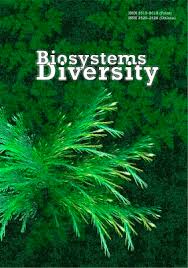Water vole (Arvicola amphibius) as an object of long-term biomonitoring in a floodplain area (Western Siberia, Russia)
Water vole (Arvicola amphibius) as an object of long-term biomonitoring in a floodplain area (Western Siberia, Russia)
Author(s): V.B. Ilyashenko, E. M. Luchnikova, A. V. KovalevskySubject(s): Regional Geography, Environmental Geography
Published by: Дніпропетровський національний університет імені Олеся Гончара
Keywords: dynamics; population; population outbreaks; cranial phenes; resettlement;
Summary/Abstract: The paper is devoted to the dynamics of the water vole population in the conditions of total deforestation of valley forests and their subsequent restoration. We analyzed the relative population of small mammals in the typical biotopes in the Tom River basin (Western Siberia) on the border of the forest-steppe and taiga zones. From 1978 to 2019, 1,139 water voles Arvicola amphibius (Linnaeus, 1758) (synonym of A. terrestris) were caught with 50-meter trapping grooves; for 788 individuals we assessed the condition of non-metric features (phenes) of the skull. It was found that changes in the population level are non-cyclical, while against the background of a generally low occurrence of the species in the region, the population level increased tenfold in some years. It was shown that such episodic population surges can significantly impact the structure of the community of small mammals. In the valley of the Tom River, the water vole prefers inhabit wet meadows and ecotone areas between the meadow and the dark coniferous taiga forest. During the years of population surges, the water vole intensely occupies new nesting sites due to the dispersal activity of young animals but at the same time retains the original biotopic preferences. Dispersal of the species takes place in waterlogged wetlands. Most of the animals caught during the peak of their numbers were young animals of late broods born from overwintered individuals. The conducted phenetic analysis revealed the heterogeneity of young animals during the population surge, which allowed us to assume the participation of several populations in the formation of the peak. In the final surge year, the surge was characterized by an extremely low percentage of participation in the breeding of young females and the appearance of a large number of weakened animals, which led to crisis in the species population and the disappearance of the water vole from the captures. The research shows that one cannot predict the success of this process at the current stage; therefore, after flooding, it is necessary to continue monitoring.
Journal: Biosystems Diversity
- Issue Year: 29/2021
- Issue No: 4
- Page Range: 393-398
- Page Count: 6
- Language: English

